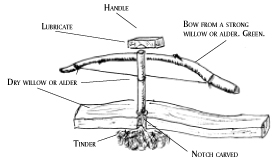Alaska Science Camps, Fairs & Experiments
ANKN is a resource for compiling and exchanging information
related to Alaska Native knowledge systems and ways of knowing. We
are pleased to create and distribute a variety of publications
that assist Native people, government agencies,
educators and the general public in gaining access to the knowledge
base that Alaska Natives have acquired through cumulative experience
over millennia.
TO ORDER THIS PUBLICATION:
Contact the ANKN
offices at 907-474-1902 or email uaf-cxcs@alaska.edu.  Traditional Traditional
Firemaking
Traditional firemaking with a bow and drill
remained a mystery to me until I was shown a few secrets.
The bow is made from a thick piece of live willow or alder. It
must be strong enough to pull the string tight.
The string can be of any stout cord.
 The
drill and bottom piece of wood should be made from soft hardwood,
that is, willow or alder. They both must be very dry but not
rotten. The
drill and bottom piece of wood should be made from soft hardwood,
that is, willow or alder. They both must be very dry but not
rotten.
The handle can be of any material. There should be a shallow hole
in the handle to fit the drill. Lubricate this. It does not need
friction.
The tinder must be of very fine materials. The "cotton" from
cottonwood works fine. Traditional materials vary from region to
region.
 Flatten
the bottom piece of dry willow or alder on two sides. With a knife or
drill, make an indentation, and then cut a "V" up to the middle of
that indentation. Flatten
the bottom piece of dry willow or alder on two sides. With a knife or
drill, make an indentation, and then cut a "V" up to the middle of
that indentation.

Twist the drill into the string of the bow. The drill should be on
the outside of the string, not the inside. If it is on the inside, it
will jam between the bow and the string. 
Put a large quantity of tinder under the bottom piece of wood.
 Start
sawing away. Friction will soon cause enough heat to make smoke.
This is as far as you are going with the bow and drill.
It will never burst into flames as we always assumed. Drilling
gets very hard once the smoke starts. Start
sawing away. Friction will soon cause enough heat to make smoke.
This is as far as you are going with the bow and drill.
It will never burst into flames as we always assumed. Drilling
gets very hard once the smoke starts.
 Quickly
scrape the glowing particles from inside of the heated groove onto
the tinder. Quickly
scrape the glowing particles from inside of the heated groove onto
the tinder.
 Fold
the tinder around the glowing particles to keep the heat in. Gently
blow on the glowing particles. As the tinder starts to glow, there
will be more smoke, but it won't flame yet. Fold
the tinder around the glowing particles to keep the heat in. Gently
blow on the glowing particles. As the tinder starts to glow, there
will be more smoke, but it won't flame yet.
Getting the tinder to burst into flame is the next step. A very
thin piece of birchbark held in the midst of glowing tinder works for
me.
I felt a great sense of accomplishment when I first did this.
After many years of knowing it was possible, I was shown and was
successful.
Try different kinds of tinder. This is the challenge. All must be
bone dry and very fine. Shredded inner cedar bark works
well, but that isn't available in most of Alaska except Southeast,
and there it is hard to find anything dry. Experiment with different
materials in your area. We also tried shredded manila rope. It was a
bit too coarse. Jute cord from a garden shop has worked for us, but
also tends to be too coarse. Materials that burn at a low temperature
are desirable. Test first with a lighter or match. If it burns easily
with a match it might also be good tinder.
Try different materials for the drill and the bottom piece of
wood. Soft deciduous trees seem to work best. Soft woods make a lot
of smoke, but don't produce glowing embers the way soft hardwoods
do.
Find out from the Elders what was traditionally used in your area.
Some regions of Alaska used flint and steel obtained through trade
routes and never did use a bow and drill.
|